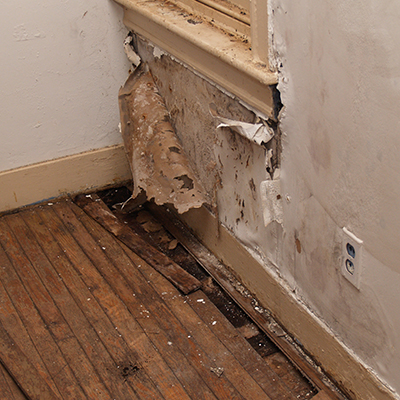
First of all, do not panic! If you have any water damage in your home, or questions about water damage, you can call us to speak with an expert. Water damage is one of the most common issues in Calgary buildings and homes. What makes it especially troublesome is that it can easily go unnoticed, leading to extended damage over time. Every property manager and homeowner should have systems in place to detect damage at the earliest stages. We want to make sure you know where to look and how to tell if you are having any water issues in your home.
How To Detect Leaky Windows

A clear sign of leaky windows is pooling or staining on the window sill, but often times water penetration can go unnoticed. Check for rusty screws on your window hardware. Look for stains in and around the sill and frame. Check the drywall beneath the windows for soft spots or bubbling in the paint. Open up the window and check the assembly for chips and staining. Look for staining in the stucco around the exterior of your window. These are all typically signs that water might be penetrating the window and leaking into the wall beneath. Knowing the full extent of damage may require further investigation.
What To Do If You Have Leaky Windows

Once water penetration becomes an issue it is important to identify the extent of the issue as early as possible. A general contractor has additional moisture detection tools that can help you know what might be happening inside the wall, but the best way to know will be to remove a section of interior drywall or exterior sheathing to see exactly what is going on. A professional should be able to provide a minimally invasive solution. Make sure that any window installation quote includes restoring any damaged materials. Never install new windows without removing and replacing all damaged material.
How To Detect Leaky Plumbing

The risk of a plumbing leak will change with the age of your home and the materials used. Calgary has hard water, meaning that it has a high mineral content. This accelerates the natural wear and tear on your pipes and plumbing components. Copper pipes will develop pin hole leaks over time with normal use. Valves and joints may also be affected. Check each plumbing fixture at the connection points for pooled water or staining. Feel for drops of water around your toilet and sink shut-off valves if you have any. Look under the sink for stains or soft spots. Check your washer-machine connections for any wetness, as well as refrigerators with water taps. Check the ceiling below each bathroom for watermarks.
What To Do If You Have Leaky Plumbing

If you do notice a problem, it is important to deal with it as soon as possible. Replace all faulty equipment and ensure there is no more leak. Remove any building materials that have been damaged beyond repair. It is a good idea to test your systems prior to making final repairs. A good general contractor will be able to help you know the extent of any damage and what items need to be replaced. Once the immediate leak is dealt with, get a fixed-price quote for the rest of the repairs.
Other Areas To Check

Check the tile grout in your showers, especially in older homes. In some cases, the tile grout is the only water barrier between your shower and the susceptible building material. If your tile grout is cracked or falling out, water could be getting into the walls. Keep an eye on your roof. There are multiple scenarios in which a roof could potentially fail and leak water into your house. Make sure the roofing materials are intact and in good condition, especially during the rainy season. Look out for ice buildup in the winter. Look for stains on your ceiling, and if you are feeling brave, get up in your attic to look for damp spots in the insulation.
What Happens If I Leave The Leak?

Water will instantly weaken the structure of building materials that are not designed to be water resistant. Any organic materials will begin to decompose, becoming weaker and weaker over time. This includes the wood framing that holds-up your house. The dark moist environment inside your walls becomes conducive for mold and bacterial growth which can have devastating effects on your health. For your own safety, and in consideration to the value of your home, do not procrastinate water issues.